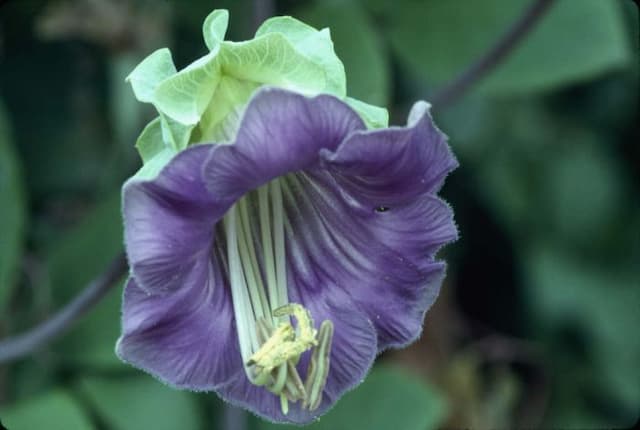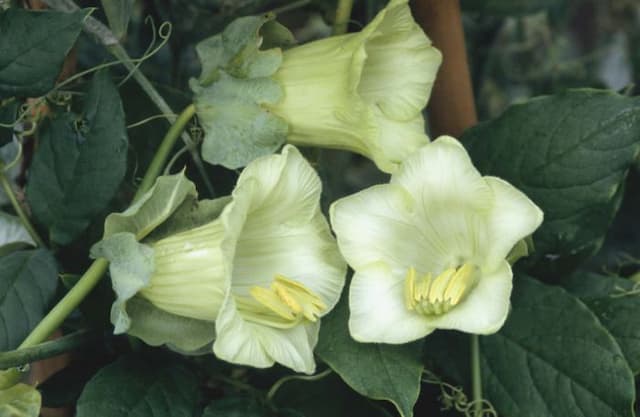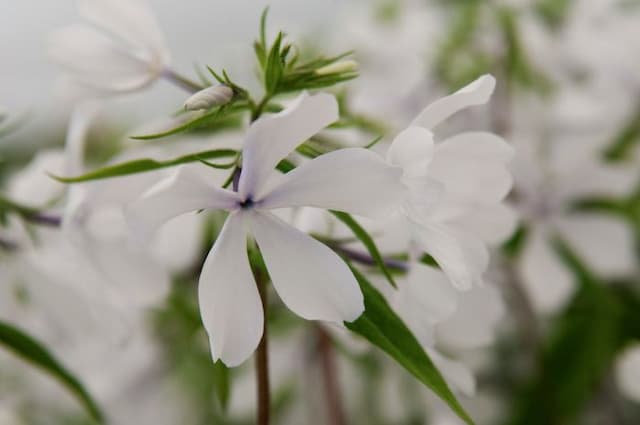Garden Phlox Phlox paniculata 'Becky Towe' (PBR) (v)

ABOUT
The Garden Phlox 'Becky Towe' is a cultivar known for its striking appearance, characterized by its vibrant flowers and variegated foliage. The plant boasts clusters of pink flowers that bloom atop sturdy stems, creating a showy display of color during the flowering season. The individual blooms exhibit a classic phlox shape, with a rounded, petal-laden form that can add a soft yet distinct texture to garden spaces. Adding to the visual interest of 'Becky Towe' is the foliage, where each leaf is edged with a creamy-yellow margin that contrasts the green center. This variegation remains eye-catching even when the plant is not in bloom, making it a focal point of the garden throughout the growing season. The leaves are oblong with a smooth or slightly toothed edge, growing densely along the stems to create a lush, full appearance. Overall, 'Becky Towe' combines floral beauty with attractive foliage, rendering it a particularly appealing selection for gardeners looking to add a splash of color and variegated interest to their landscape. Its bright blooms and decorative leaves make it a standout among garden phlox varieties.
About this plant
 Names
NamesFamily
Polemoniaceae
Synonyms
Garden Phlox, Summer Phlox, Perennial Phlox, Fall Phlox
Common names
Phlox paniculata 'Becky Towe'
 Toxicity
ToxicityTo humans
Garden phlox is not considered to be toxic to humans. There is generally no concern if the plant is accidentally ingested in small quantities. However, individual allergic reactions or sensitivities could occur, leading to mild gastrointestinal discomfort. Serious poisoning from garden phlox is not commonly reported or documented.
To pets
Garden phlox is not known to be toxic to pets. If pets were to ingest parts of the plant, they are unlikely to experience any significant symptoms of poisoning. Nonetheless, as is the case with any non-food plant, ingestion can sometimes lead to mild gastrointestinal upset like vomiting or diarrhea if eaten in large enough quantities or if the pet has a particularly sensitive stomach.
 Characteristics
CharacteristicsLife cycle
Perennials
Foliage type
Deciduous
Color of leaves
Variegated
Flower color
Pink
Height
2-3 feet (0.6-0.9 meters)
Spread
1-2 feet (0.3-0.6 meters)
Plant type
Herb
Hardiness zones
4
Native area
North America
Benefits
 General Benefits
General Benefits- Attracts Pollinators: Phlox paniculata 'Becky Towe' is known for its brightly colored flowers which attract a variety of pollinators, such as bees, butterflies, and hummingbirds.
- Enhances Garden Aesthetics: With its striking pink and white variegated foliage, it adds a splash of color that enhances the beauty and aesthetic appeal of gardens.
- Ease of Cultivation: Garden Phlox is relatively easy to grow and can thrive in a range of garden settings, making it accessible to many gardeners.
- Long Blooming Period: The plant has a long flowering season, usually from mid to late summer, providing color and interest in the garden for an extended period.
- Fragrance: The flowers of Garden Phlox are known for their sweet fragrance, which can add an additional sensory experience to a garden or landscape.
- Cut Flower Use: Due to its attractive blossoms and long stems, this plant is an excellent choice for cut flower arrangements.
- Herbaceous Perennial: As a perennial, it returns year after year, providing a reliable feature in a perennial bedding scheme.
- Versatile Planting Options: It can be used in a variety of garden situations, including borders, cottage gardens, and formal beds.
- Survives in Different Climates: Phlox paniculata is tolerant of a variety of climates and can survive cold winters with proper care.
- Resistant to Deer: It is considered to be deer resistant, reducing the risk of damage from wildlife.
 Medical Properties
Medical PropertiesThis plant is not used for medical purposes.
 Air-purifying Qualities
Air-purifying QualitiesThis plant is not specifically known for air purifying qualities.
 Other Uses
Other Uses- Phlox paniculata 'Becky Towe' can be used as a natural fabric dye, providing a range of pink to lavender colors depending on the mordant used.
- The plant can serve as a source of inspiration for artists and designers, with its variegated foliage and pink flowers influencing patterns and color schemes.
- Garden bordering is another use, as its upright habit and colorful presence can define the edges of garden beds or walkways.
- Phlox paniculata 'Becky Towe' is suitable for butterfly gardens, attracting a variety of butterflies and pollinators to the area due to its nectar-rich flowers.
- Used in educational settings such as schools or botanical gardens, this variety of phlox can help teach about plant life cycles and hybrid plant development.
- The plant's aromatic flowers can be included in potpourri mixes, providing a pleasant fragrance to indoor environments.
- In floral language and symbolism, Phlox paniculata 'Becky Towe' can represent unity or harmony, making it a meaningful addition to gardens commemorating relationships or community spaces.
- Planting it in a moon garden, which is designed to be enjoyed at night, can be effective as the flowers tend to be more visible and the fragrance more perceptible in the evening.
- As a companion plant, it can be used to bring beneficial insects to the garden that help control pest populations naturally.
- Pressing the flowers for craft purposes allows for the creation of unique bookmarks, greeting cards, or framed botanical art.
Interesting Facts
 Feng Shui
Feng ShuiThe garden phlox is not used in Feng Shui practice.
 Zodiac Sign Compitability
Zodiac Sign CompitabilityThe garden phlox is not used in astrology practice.
 Plant Symbolism
Plant Symbolism- Agreement - Phlox in general signifies harmony and consensus, making 'Becky Towe' a symbol for mutual understanding and unity.
- Proposal - With its clusters of flowers, phlox is sometimes associated with an offering of a proposal or a proposition, fitting for 'Becky Towe' to represent a romantic gesture.
- Sweet dreams - The phlox, due to its sweet fragrance, can symbolize wishing someone sweet dreams, making 'Becky Towe' ideal for expressing a desire for tranquility at night.
 Water
WaterGarden phlox should be watered deeply and thoroughly about once a week, ensuring the plant receives approximately 1 inch of water. During hot or dry spells, the frequency may increase to twice a week. Avoid overhead watering to prevent mildew; instead, use a soaker hose or water at the base of the plant to keep the foliage dry. Ensure sufficient drainage as phlox does not like to be waterlogged.
 Light
LightGarden phlox thrives in full sun but can tolerate partial shade. The best spot for garden phlox is an area that receives at least six hours of direct sunlight each day. However, in extremely hot climates, a location with morning sun and afternoon shade can help protect the plant from intense heat.
 Temperature
TemperatureGarden phlox is hardy in a range of temperatures and can survive minimum winter temperatures down to -20°F. It performs best in the summer when the temperatures hover between 65°F and 85°F. Excessive heat can cause stress, so providing some afternoon shade in hotter regions is beneficial.
 Pruning
PruningGarden phlox should be pruned to encourage bushier growth, improve air circulation, and reduce the risk of disease. Deadheading spent flowers will promote further blooming. The best time for pruning is in the spring when new shoots appear, at which point you can cut back any dead or damaged stems from the previous year.
 Cleaning
CleaningAs needed
 Soil
SoilGarden Phlox, or Phlox paniculata 'Becky Towe', requires well-drained soil rich in organic matter with a pH of 6.5 to 7.0. A good soil mix can be created with equal parts garden soil, compost, and peat moss to ensure good drainage and fertility.
 Repotting
RepottingGarden Phlox, commonly known as Phlox paniculata 'Becky Towe', doesn't need regular repotting as it's a perennial garden plant. Instead, it is divided every 3 to 4 years to maintain vigor.
 Humidity & Misting
Humidity & MistingGarden Phlox prefers moderate humidity levels. To thrive well, it requires an environment that is neither too dry nor excessively humid as it is adaptable to typical outdoor humidity ranges.
 Suitable locations
Suitable locationsIndoor
Ensure good light, moist soil, and proper airflow.
Outdoor
Provide full sun, moist soil, and space for air circulation.
Hardiness zone
4-8 USDA
 Life cycle
Life cyclePhlox paniculata 'Becky Towe', commonly known as Garden Phlox, begins its life as a seed, which upon germination in early spring, develops into a seedling with the emergence of primary roots and shoots. As it grows through spring and summer, the seedling develops into a vegetative state characterized by the growth of its distinctive lance-shaped foliage and robust stem structure. During late spring to summer, the plant enters the reproductive phase, producing clusters of fragrant, variegated pink and yellow flowers that attract pollinators and are capable of setting seed for the next generation. After pollination, the flowers develop into small, dry fruit containing seeds that mature by late summer or early fall. As temperatures decrease in autumn, the plant begins to exhibit reduced growth and prepares for dormancy, withering above-ground parts while the root system remains alive underground. With the return of favorable spring conditions, Garden Phlox re-emerges from the rootstock, completing the cycle and beginning a new growth phase.
 Propogation
PropogationPropogation time
Spring-Early Summer
Propogation: Phlox paniculata 'Becky Towe', commonly known as Garden Phlox, is typically propagated by division, which is the most popular method for this perennial flower. Division should ideally be performed in early spring or late summer after the blooming period. To propagate by division, carefully dig up the clump of phlox, ensuring to get as much of the root system as possible. Gently separate the clump into smaller sections, each with several shoots and a good amount of roots attached. These sections can then be replanted into well-draining soil, spaced approximately 15-18 inches (38-45 centimeters) apart to allow adequate room for growth. Water the newly planted divisions thoroughly to help establish them. This method of propagation not only helps to rejuvenate older clumps that may be losing vitality but also increases the number of plants in your garden.









